Integrated Case Study Analysis of KIA Motors India
VerifiedAdded on 2023/06/15
|13
|4390
|316
AI Summary
This report is based on integrated case study analysis of an organisation and to demonstrate different aspects of this report, Second case study of KIA Motors India is taken into consideration as an organisation. In order to complete various aspects of this report, the problems that are faced by the respective organisation for achieving its organisational objectives will be discussed. This report also includes the background of the company in order to make an analysis on the business operations of the company.
Contribute Materials
Your contribution can guide someone’s learning journey. Share your
documents today.
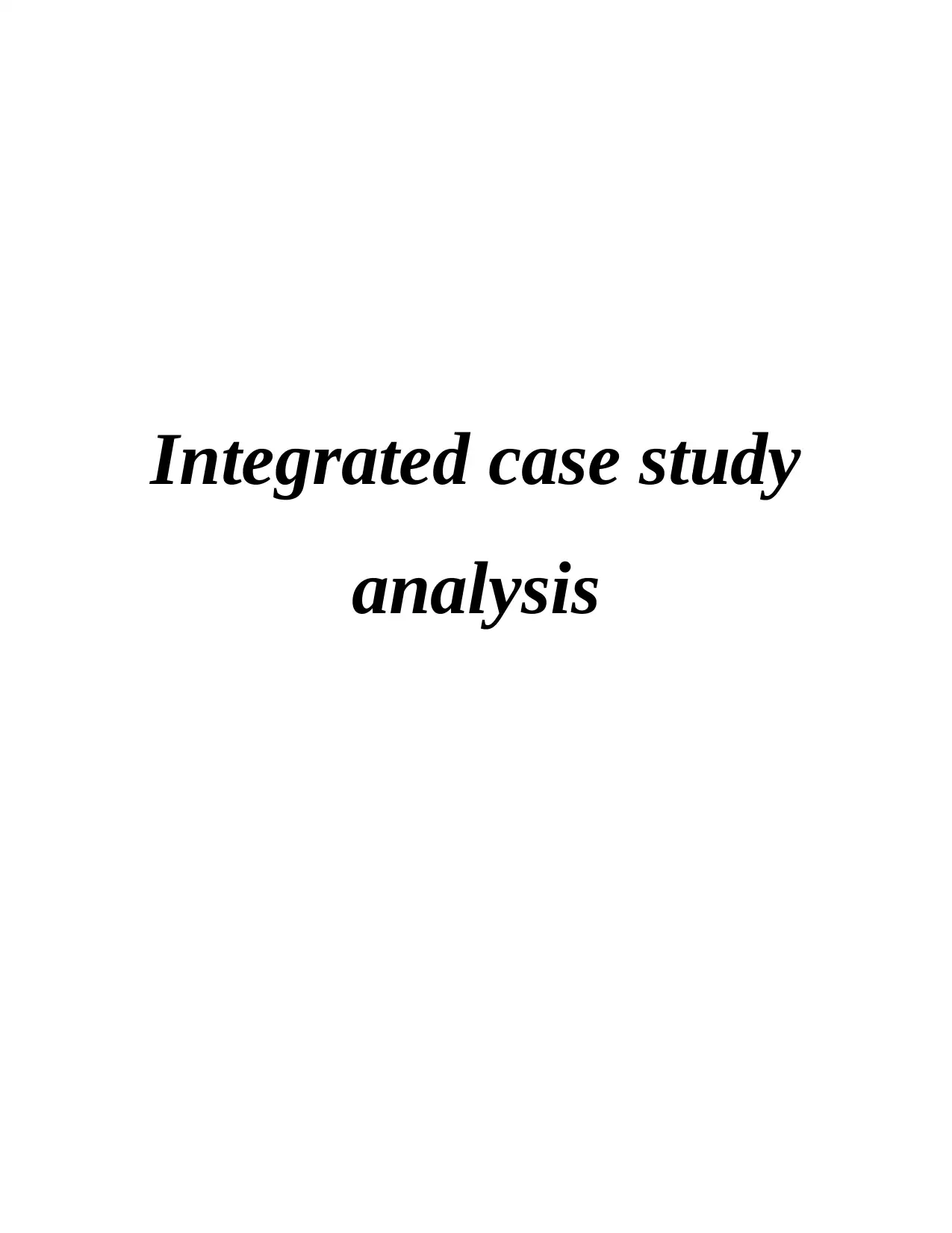
Integrated case study
analysis
analysis
Secure Best Marks with AI Grader
Need help grading? Try our AI Grader for instant feedback on your assignments.
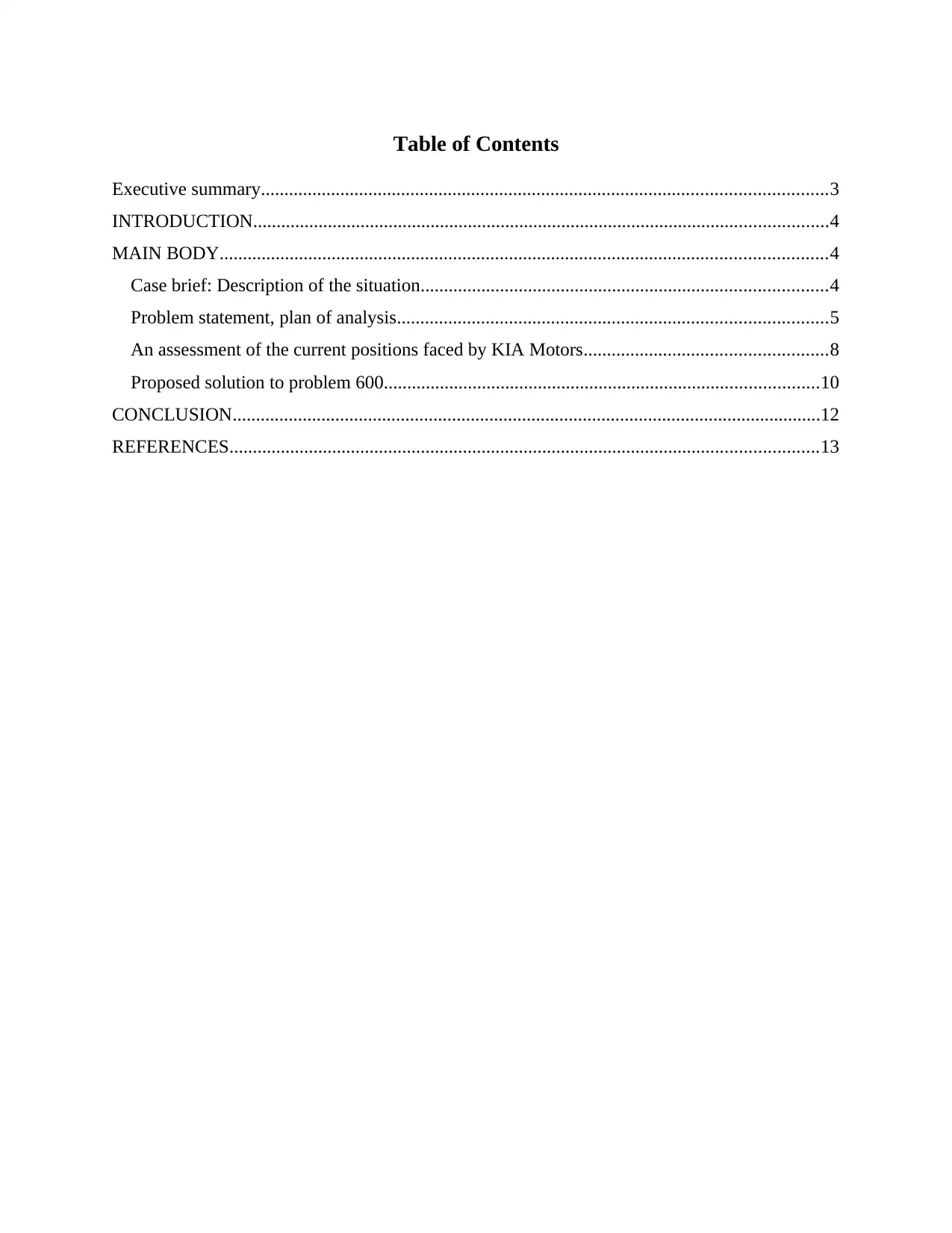
Table of Contents
Executive summary.........................................................................................................................3
INTRODUCTION...........................................................................................................................4
MAIN BODY..................................................................................................................................4
Case brief: Description of the situation.......................................................................................4
Problem statement, plan of analysis............................................................................................5
An assessment of the current positions faced by KIA Motors....................................................8
Proposed solution to problem 600.............................................................................................10
CONCLUSION..............................................................................................................................12
REFERENCES..............................................................................................................................13
Executive summary.........................................................................................................................3
INTRODUCTION...........................................................................................................................4
MAIN BODY..................................................................................................................................4
Case brief: Description of the situation.......................................................................................4
Problem statement, plan of analysis............................................................................................5
An assessment of the current positions faced by KIA Motors....................................................8
Proposed solution to problem 600.............................................................................................10
CONCLUSION..............................................................................................................................12
REFERENCES..............................................................................................................................13
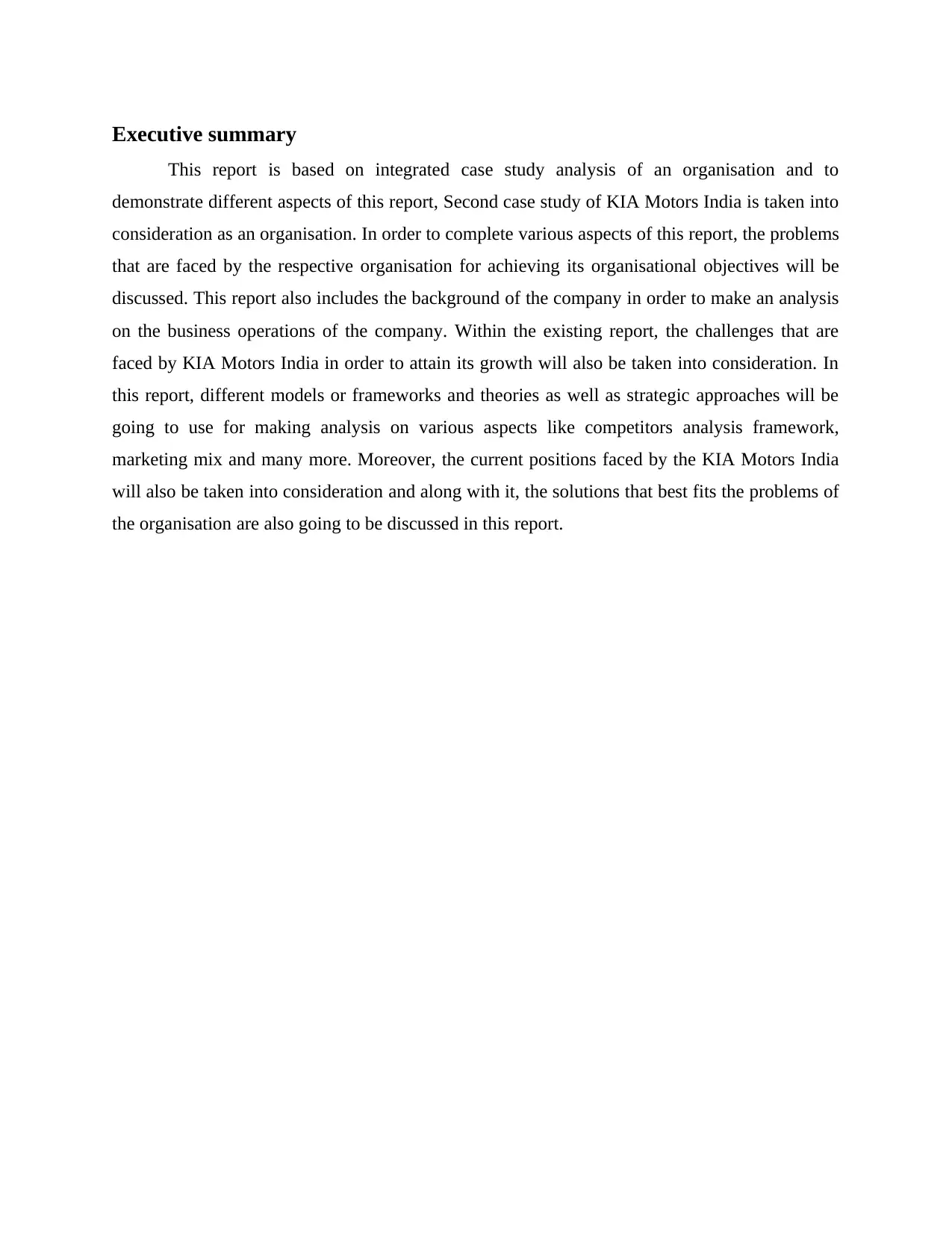
Executive summary
This report is based on integrated case study analysis of an organisation and to
demonstrate different aspects of this report, Second case study of KIA Motors India is taken into
consideration as an organisation. In order to complete various aspects of this report, the problems
that are faced by the respective organisation for achieving its organisational objectives will be
discussed. This report also includes the background of the company in order to make an analysis
on the business operations of the company. Within the existing report, the challenges that are
faced by KIA Motors India in order to attain its growth will also be taken into consideration. In
this report, different models or frameworks and theories as well as strategic approaches will be
going to use for making analysis on various aspects like competitors analysis framework,
marketing mix and many more. Moreover, the current positions faced by the KIA Motors India
will also be taken into consideration and along with it, the solutions that best fits the problems of
the organisation are also going to be discussed in this report.
This report is based on integrated case study analysis of an organisation and to
demonstrate different aspects of this report, Second case study of KIA Motors India is taken into
consideration as an organisation. In order to complete various aspects of this report, the problems
that are faced by the respective organisation for achieving its organisational objectives will be
discussed. This report also includes the background of the company in order to make an analysis
on the business operations of the company. Within the existing report, the challenges that are
faced by KIA Motors India in order to attain its growth will also be taken into consideration. In
this report, different models or frameworks and theories as well as strategic approaches will be
going to use for making analysis on various aspects like competitors analysis framework,
marketing mix and many more. Moreover, the current positions faced by the KIA Motors India
will also be taken into consideration and along with it, the solutions that best fits the problems of
the organisation are also going to be discussed in this report.
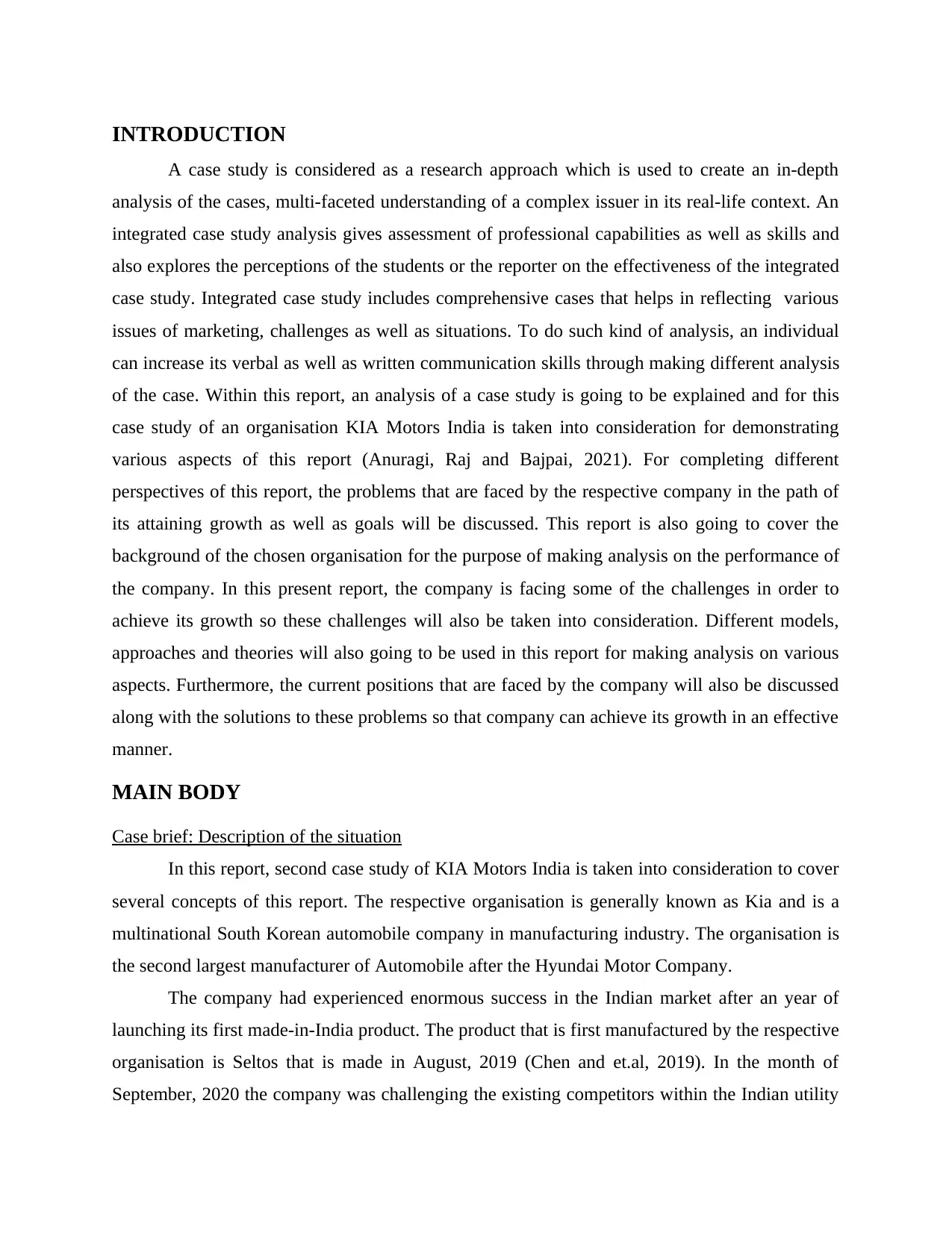
INTRODUCTION
A case study is considered as a research approach which is used to create an in-depth
analysis of the cases, multi-faceted understanding of a complex issuer in its real-life context. An
integrated case study analysis gives assessment of professional capabilities as well as skills and
also explores the perceptions of the students or the reporter on the effectiveness of the integrated
case study. Integrated case study includes comprehensive cases that helps in reflecting various
issues of marketing, challenges as well as situations. To do such kind of analysis, an individual
can increase its verbal as well as written communication skills through making different analysis
of the case. Within this report, an analysis of a case study is going to be explained and for this
case study of an organisation KIA Motors India is taken into consideration for demonstrating
various aspects of this report (Anuragi, Raj and Bajpai, 2021). For completing different
perspectives of this report, the problems that are faced by the respective company in the path of
its attaining growth as well as goals will be discussed. This report is also going to cover the
background of the chosen organisation for the purpose of making analysis on the performance of
the company. In this present report, the company is facing some of the challenges in order to
achieve its growth so these challenges will also be taken into consideration. Different models,
approaches and theories will also going to be used in this report for making analysis on various
aspects. Furthermore, the current positions that are faced by the company will also be discussed
along with the solutions to these problems so that company can achieve its growth in an effective
manner.
MAIN BODY
Case brief: Description of the situation
In this report, second case study of KIA Motors India is taken into consideration to cover
several concepts of this report. The respective organisation is generally known as Kia and is a
multinational South Korean automobile company in manufacturing industry. The organisation is
the second largest manufacturer of Automobile after the Hyundai Motor Company.
The company had experienced enormous success in the Indian market after an year of
launching its first made-in-India product. The product that is first manufactured by the respective
organisation is Seltos that is made in August, 2019 (Chen and et.al, 2019). In the month of
September, 2020 the company was challenging the existing competitors within the Indian utility
A case study is considered as a research approach which is used to create an in-depth
analysis of the cases, multi-faceted understanding of a complex issuer in its real-life context. An
integrated case study analysis gives assessment of professional capabilities as well as skills and
also explores the perceptions of the students or the reporter on the effectiveness of the integrated
case study. Integrated case study includes comprehensive cases that helps in reflecting various
issues of marketing, challenges as well as situations. To do such kind of analysis, an individual
can increase its verbal as well as written communication skills through making different analysis
of the case. Within this report, an analysis of a case study is going to be explained and for this
case study of an organisation KIA Motors India is taken into consideration for demonstrating
various aspects of this report (Anuragi, Raj and Bajpai, 2021). For completing different
perspectives of this report, the problems that are faced by the respective company in the path of
its attaining growth as well as goals will be discussed. This report is also going to cover the
background of the chosen organisation for the purpose of making analysis on the performance of
the company. In this present report, the company is facing some of the challenges in order to
achieve its growth so these challenges will also be taken into consideration. Different models,
approaches and theories will also going to be used in this report for making analysis on various
aspects. Furthermore, the current positions that are faced by the company will also be discussed
along with the solutions to these problems so that company can achieve its growth in an effective
manner.
MAIN BODY
Case brief: Description of the situation
In this report, second case study of KIA Motors India is taken into consideration to cover
several concepts of this report. The respective organisation is generally known as Kia and is a
multinational South Korean automobile company in manufacturing industry. The organisation is
the second largest manufacturer of Automobile after the Hyundai Motor Company.
The company had experienced enormous success in the Indian market after an year of
launching its first made-in-India product. The product that is first manufactured by the respective
organisation is Seltos that is made in August, 2019 (Chen and et.al, 2019). In the month of
September, 2020 the company was challenging the existing competitors within the Indian utility
Secure Best Marks with AI Grader
Need help grading? Try our AI Grader for instant feedback on your assignments.
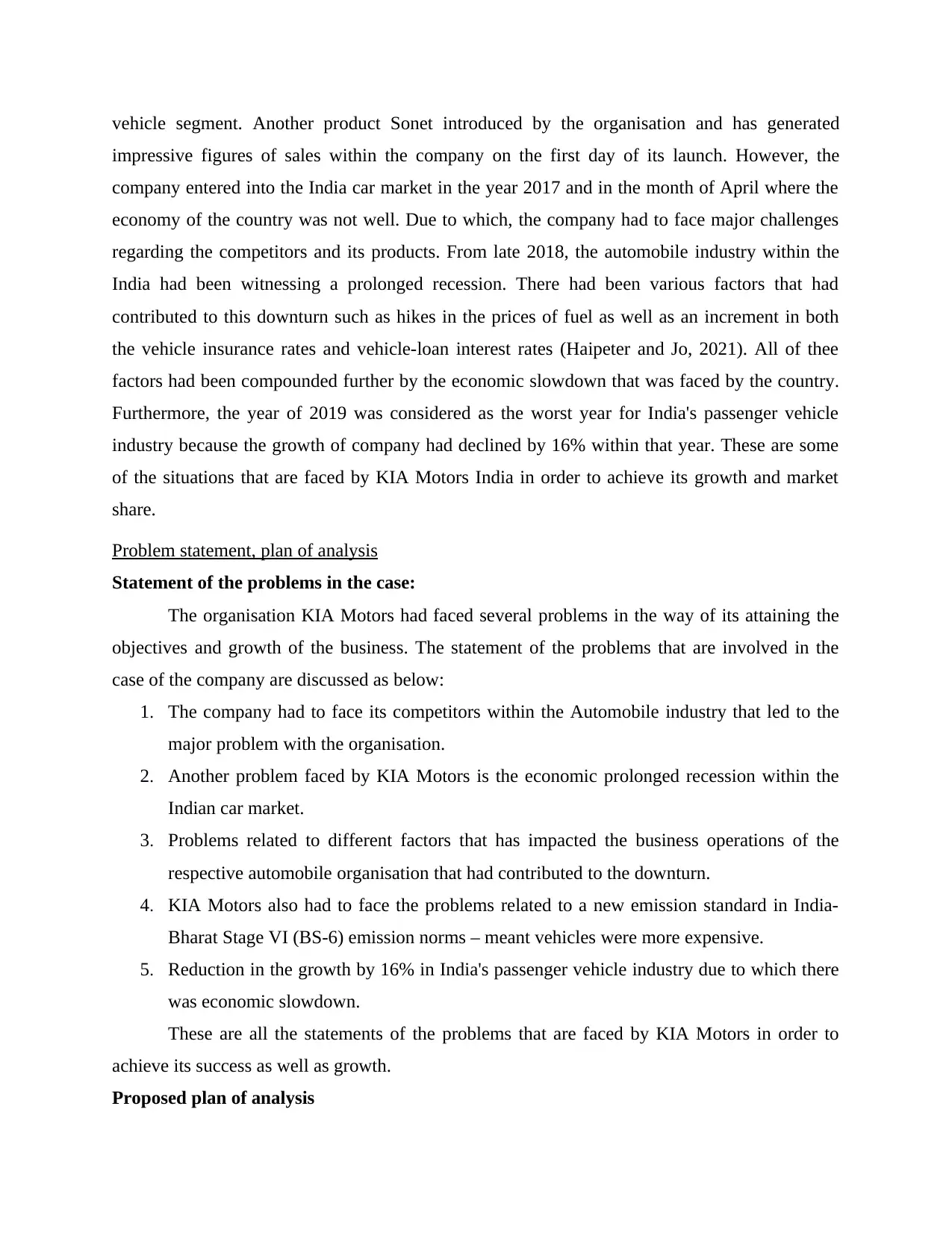
vehicle segment. Another product Sonet introduced by the organisation and has generated
impressive figures of sales within the company on the first day of its launch. However, the
company entered into the India car market in the year 2017 and in the month of April where the
economy of the country was not well. Due to which, the company had to face major challenges
regarding the competitors and its products. From late 2018, the automobile industry within the
India had been witnessing a prolonged recession. There had been various factors that had
contributed to this downturn such as hikes in the prices of fuel as well as an increment in both
the vehicle insurance rates and vehicle-loan interest rates (Haipeter and Jo, 2021). All of thee
factors had been compounded further by the economic slowdown that was faced by the country.
Furthermore, the year of 2019 was considered as the worst year for India's passenger vehicle
industry because the growth of company had declined by 16% within that year. These are some
of the situations that are faced by KIA Motors India in order to achieve its growth and market
share.
Problem statement, plan of analysis
Statement of the problems in the case:
The organisation KIA Motors had faced several problems in the way of its attaining the
objectives and growth of the business. The statement of the problems that are involved in the
case of the company are discussed as below:
1. The company had to face its competitors within the Automobile industry that led to the
major problem with the organisation.
2. Another problem faced by KIA Motors is the economic prolonged recession within the
Indian car market.
3. Problems related to different factors that has impacted the business operations of the
respective automobile organisation that had contributed to the downturn.
4. KIA Motors also had to face the problems related to a new emission standard in India-
Bharat Stage VI (BS-6) emission norms – meant vehicles were more expensive.
5. Reduction in the growth by 16% in India's passenger vehicle industry due to which there
was economic slowdown.
These are all the statements of the problems that are faced by KIA Motors in order to
achieve its success as well as growth.
Proposed plan of analysis
impressive figures of sales within the company on the first day of its launch. However, the
company entered into the India car market in the year 2017 and in the month of April where the
economy of the country was not well. Due to which, the company had to face major challenges
regarding the competitors and its products. From late 2018, the automobile industry within the
India had been witnessing a prolonged recession. There had been various factors that had
contributed to this downturn such as hikes in the prices of fuel as well as an increment in both
the vehicle insurance rates and vehicle-loan interest rates (Haipeter and Jo, 2021). All of thee
factors had been compounded further by the economic slowdown that was faced by the country.
Furthermore, the year of 2019 was considered as the worst year for India's passenger vehicle
industry because the growth of company had declined by 16% within that year. These are some
of the situations that are faced by KIA Motors India in order to achieve its growth and market
share.
Problem statement, plan of analysis
Statement of the problems in the case:
The organisation KIA Motors had faced several problems in the way of its attaining the
objectives and growth of the business. The statement of the problems that are involved in the
case of the company are discussed as below:
1. The company had to face its competitors within the Automobile industry that led to the
major problem with the organisation.
2. Another problem faced by KIA Motors is the economic prolonged recession within the
Indian car market.
3. Problems related to different factors that has impacted the business operations of the
respective automobile organisation that had contributed to the downturn.
4. KIA Motors also had to face the problems related to a new emission standard in India-
Bharat Stage VI (BS-6) emission norms – meant vehicles were more expensive.
5. Reduction in the growth by 16% in India's passenger vehicle industry due to which there
was economic slowdown.
These are all the statements of the problems that are faced by KIA Motors in order to
achieve its success as well as growth.
Proposed plan of analysis
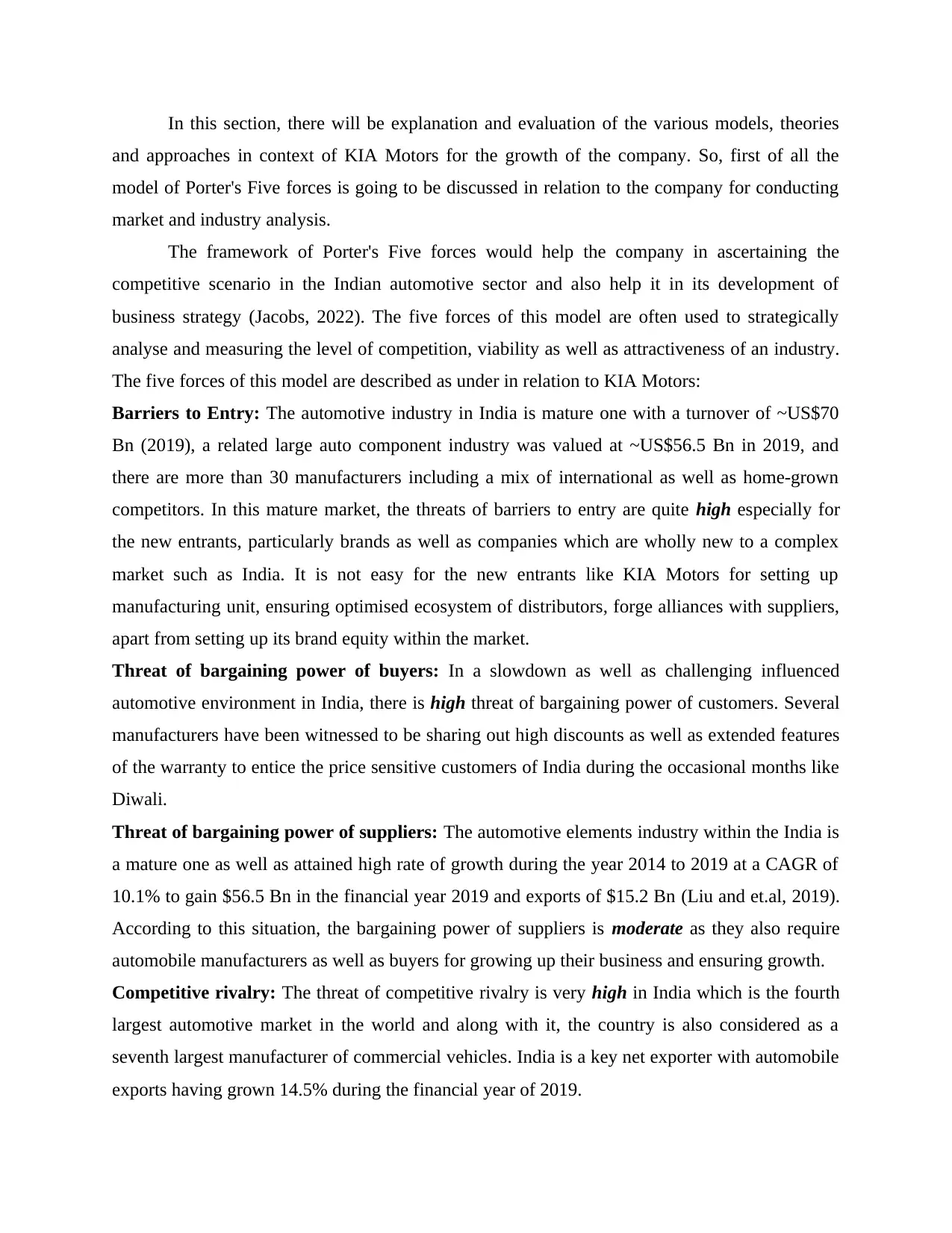
In this section, there will be explanation and evaluation of the various models, theories
and approaches in context of KIA Motors for the growth of the company. So, first of all the
model of Porter's Five forces is going to be discussed in relation to the company for conducting
market and industry analysis.
The framework of Porter's Five forces would help the company in ascertaining the
competitive scenario in the Indian automotive sector and also help it in its development of
business strategy (Jacobs, 2022). The five forces of this model are often used to strategically
analyse and measuring the level of competition, viability as well as attractiveness of an industry.
The five forces of this model are described as under in relation to KIA Motors:
Barriers to Entry: The automotive industry in India is mature one with a turnover of ~US$70
Bn (2019), a related large auto component industry was valued at ~US$56.5 Bn in 2019, and
there are more than 30 manufacturers including a mix of international as well as home-grown
competitors. In this mature market, the threats of barriers to entry are quite high especially for
the new entrants, particularly brands as well as companies which are wholly new to a complex
market such as India. It is not easy for the new entrants like KIA Motors for setting up
manufacturing unit, ensuring optimised ecosystem of distributors, forge alliances with suppliers,
apart from setting up its brand equity within the market.
Threat of bargaining power of buyers: In a slowdown as well as challenging influenced
automotive environment in India, there is high threat of bargaining power of customers. Several
manufacturers have been witnessed to be sharing out high discounts as well as extended features
of the warranty to entice the price sensitive customers of India during the occasional months like
Diwali.
Threat of bargaining power of suppliers: The automotive elements industry within the India is
a mature one as well as attained high rate of growth during the year 2014 to 2019 at a CAGR of
10.1% to gain $56.5 Bn in the financial year 2019 and exports of $15.2 Bn (Liu and et.al, 2019).
According to this situation, the bargaining power of suppliers is moderate as they also require
automobile manufacturers as well as buyers for growing up their business and ensuring growth.
Competitive rivalry: The threat of competitive rivalry is very high in India which is the fourth
largest automotive market in the world and along with it, the country is also considered as a
seventh largest manufacturer of commercial vehicles. India is a key net exporter with automobile
exports having grown 14.5% during the financial year of 2019.
and approaches in context of KIA Motors for the growth of the company. So, first of all the
model of Porter's Five forces is going to be discussed in relation to the company for conducting
market and industry analysis.
The framework of Porter's Five forces would help the company in ascertaining the
competitive scenario in the Indian automotive sector and also help it in its development of
business strategy (Jacobs, 2022). The five forces of this model are often used to strategically
analyse and measuring the level of competition, viability as well as attractiveness of an industry.
The five forces of this model are described as under in relation to KIA Motors:
Barriers to Entry: The automotive industry in India is mature one with a turnover of ~US$70
Bn (2019), a related large auto component industry was valued at ~US$56.5 Bn in 2019, and
there are more than 30 manufacturers including a mix of international as well as home-grown
competitors. In this mature market, the threats of barriers to entry are quite high especially for
the new entrants, particularly brands as well as companies which are wholly new to a complex
market such as India. It is not easy for the new entrants like KIA Motors for setting up
manufacturing unit, ensuring optimised ecosystem of distributors, forge alliances with suppliers,
apart from setting up its brand equity within the market.
Threat of bargaining power of buyers: In a slowdown as well as challenging influenced
automotive environment in India, there is high threat of bargaining power of customers. Several
manufacturers have been witnessed to be sharing out high discounts as well as extended features
of the warranty to entice the price sensitive customers of India during the occasional months like
Diwali.
Threat of bargaining power of suppliers: The automotive elements industry within the India is
a mature one as well as attained high rate of growth during the year 2014 to 2019 at a CAGR of
10.1% to gain $56.5 Bn in the financial year 2019 and exports of $15.2 Bn (Liu and et.al, 2019).
According to this situation, the bargaining power of suppliers is moderate as they also require
automobile manufacturers as well as buyers for growing up their business and ensuring growth.
Competitive rivalry: The threat of competitive rivalry is very high in India which is the fourth
largest automotive market in the world and along with it, the country is also considered as a
seventh largest manufacturer of commercial vehicles. India is a key net exporter with automobile
exports having grown 14.5% during the financial year of 2019.
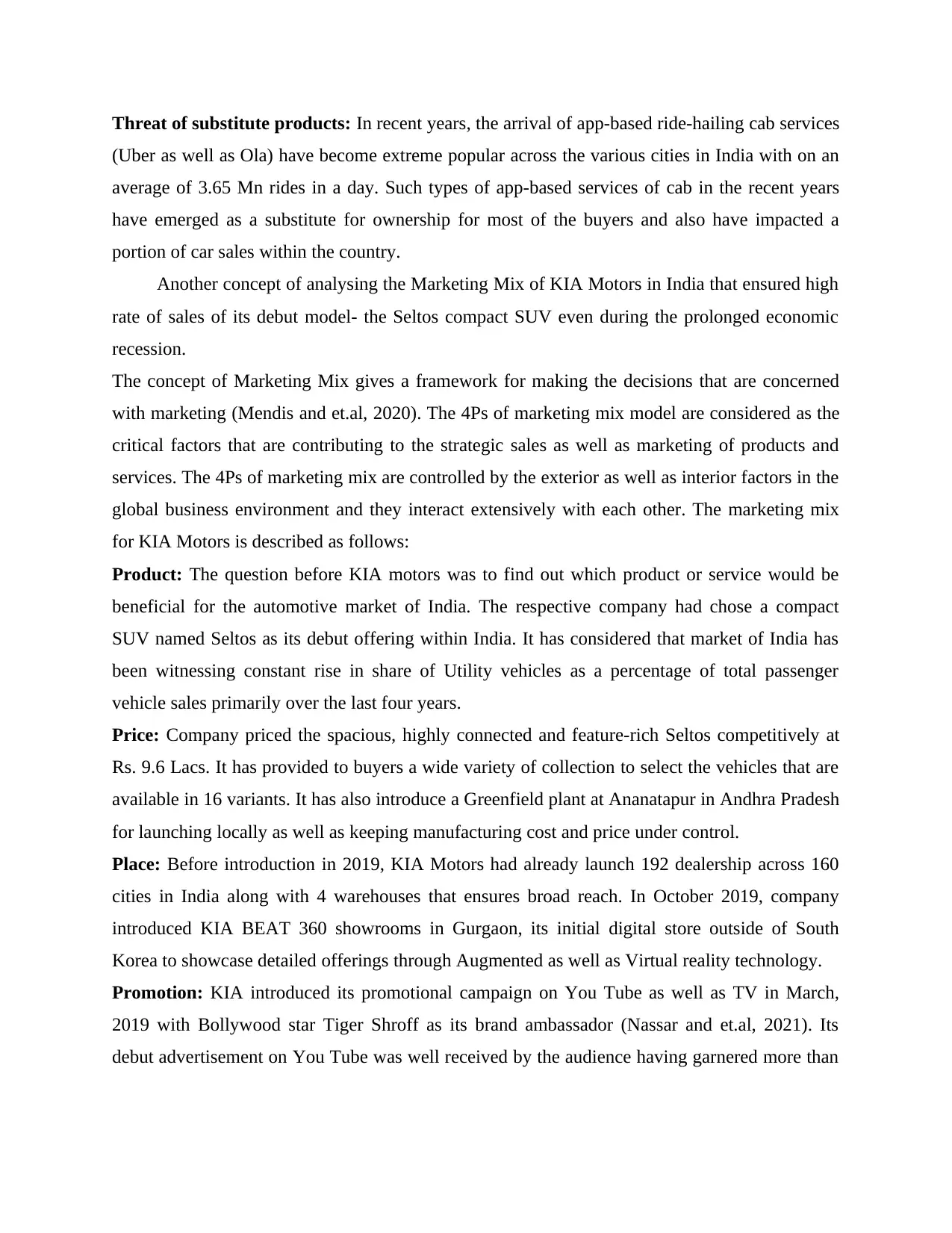
Threat of substitute products: In recent years, the arrival of app-based ride-hailing cab services
(Uber as well as Ola) have become extreme popular across the various cities in India with on an
average of 3.65 Mn rides in a day. Such types of app-based services of cab in the recent years
have emerged as a substitute for ownership for most of the buyers and also have impacted a
portion of car sales within the country.
Another concept of analysing the Marketing Mix of KIA Motors in India that ensured high
rate of sales of its debut model- the Seltos compact SUV even during the prolonged economic
recession.
The concept of Marketing Mix gives a framework for making the decisions that are concerned
with marketing (Mendis and et.al, 2020). The 4Ps of marketing mix model are considered as the
critical factors that are contributing to the strategic sales as well as marketing of products and
services. The 4Ps of marketing mix are controlled by the exterior as well as interior factors in the
global business environment and they interact extensively with each other. The marketing mix
for KIA Motors is described as follows:
Product: The question before KIA motors was to find out which product or service would be
beneficial for the automotive market of India. The respective company had chose a compact
SUV named Seltos as its debut offering within India. It has considered that market of India has
been witnessing constant rise in share of Utility vehicles as a percentage of total passenger
vehicle sales primarily over the last four years.
Price: Company priced the spacious, highly connected and feature-rich Seltos competitively at
Rs. 9.6 Lacs. It has provided to buyers a wide variety of collection to select the vehicles that are
available in 16 variants. It has also introduce a Greenfield plant at Ananatapur in Andhra Pradesh
for launching locally as well as keeping manufacturing cost and price under control.
Place: Before introduction in 2019, KIA Motors had already launch 192 dealership across 160
cities in India along with 4 warehouses that ensures broad reach. In October 2019, company
introduced KIA BEAT 360 showrooms in Gurgaon, its initial digital store outside of South
Korea to showcase detailed offerings through Augmented as well as Virtual reality technology.
Promotion: KIA introduced its promotional campaign on You Tube as well as TV in March,
2019 with Bollywood star Tiger Shroff as its brand ambassador (Nassar and et.al, 2021). Its
debut advertisement on You Tube was well received by the audience having garnered more than
(Uber as well as Ola) have become extreme popular across the various cities in India with on an
average of 3.65 Mn rides in a day. Such types of app-based services of cab in the recent years
have emerged as a substitute for ownership for most of the buyers and also have impacted a
portion of car sales within the country.
Another concept of analysing the Marketing Mix of KIA Motors in India that ensured high
rate of sales of its debut model- the Seltos compact SUV even during the prolonged economic
recession.
The concept of Marketing Mix gives a framework for making the decisions that are concerned
with marketing (Mendis and et.al, 2020). The 4Ps of marketing mix model are considered as the
critical factors that are contributing to the strategic sales as well as marketing of products and
services. The 4Ps of marketing mix are controlled by the exterior as well as interior factors in the
global business environment and they interact extensively with each other. The marketing mix
for KIA Motors is described as follows:
Product: The question before KIA motors was to find out which product or service would be
beneficial for the automotive market of India. The respective company had chose a compact
SUV named Seltos as its debut offering within India. It has considered that market of India has
been witnessing constant rise in share of Utility vehicles as a percentage of total passenger
vehicle sales primarily over the last four years.
Price: Company priced the spacious, highly connected and feature-rich Seltos competitively at
Rs. 9.6 Lacs. It has provided to buyers a wide variety of collection to select the vehicles that are
available in 16 variants. It has also introduce a Greenfield plant at Ananatapur in Andhra Pradesh
for launching locally as well as keeping manufacturing cost and price under control.
Place: Before introduction in 2019, KIA Motors had already launch 192 dealership across 160
cities in India along with 4 warehouses that ensures broad reach. In October 2019, company
introduced KIA BEAT 360 showrooms in Gurgaon, its initial digital store outside of South
Korea to showcase detailed offerings through Augmented as well as Virtual reality technology.
Promotion: KIA introduced its promotional campaign on You Tube as well as TV in March,
2019 with Bollywood star Tiger Shroff as its brand ambassador (Nassar and et.al, 2021). Its
debut advertisement on You Tube was well received by the audience having garnered more than
Paraphrase This Document
Need a fresh take? Get an instant paraphrase of this document with our AI Paraphraser
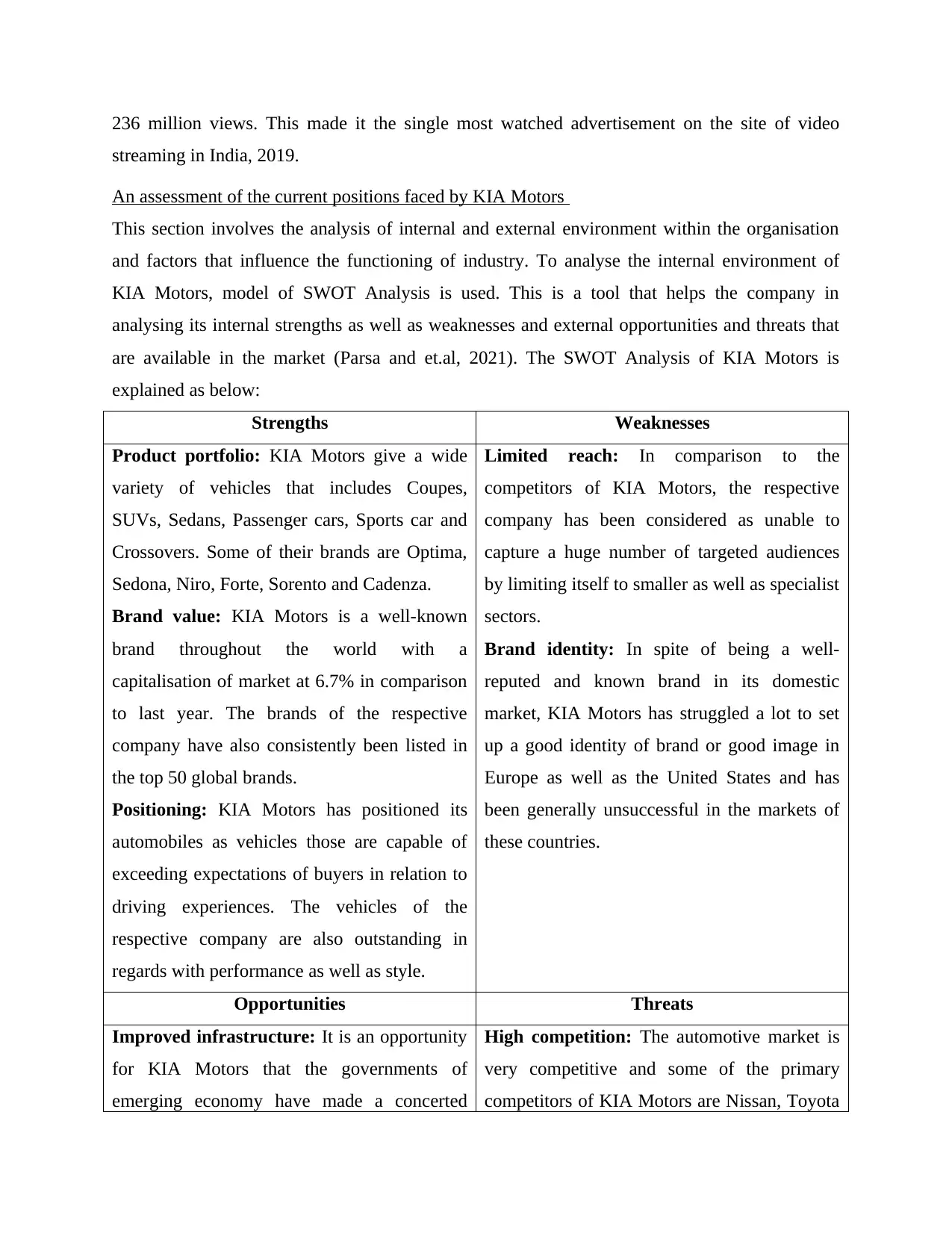
236 million views. This made it the single most watched advertisement on the site of video
streaming in India, 2019.
An assessment of the current positions faced by KIA Motors
This section involves the analysis of internal and external environment within the organisation
and factors that influence the functioning of industry. To analyse the internal environment of
KIA Motors, model of SWOT Analysis is used. This is a tool that helps the company in
analysing its internal strengths as well as weaknesses and external opportunities and threats that
are available in the market (Parsa and et.al, 2021). The SWOT Analysis of KIA Motors is
explained as below:
Strengths Weaknesses
Product portfolio: KIA Motors give a wide
variety of vehicles that includes Coupes,
SUVs, Sedans, Passenger cars, Sports car and
Crossovers. Some of their brands are Optima,
Sedona, Niro, Forte, Sorento and Cadenza.
Brand value: KIA Motors is a well-known
brand throughout the world with a
capitalisation of market at 6.7% in comparison
to last year. The brands of the respective
company have also consistently been listed in
the top 50 global brands.
Positioning: KIA Motors has positioned its
automobiles as vehicles those are capable of
exceeding expectations of buyers in relation to
driving experiences. The vehicles of the
respective company are also outstanding in
regards with performance as well as style.
Limited reach: In comparison to the
competitors of KIA Motors, the respective
company has been considered as unable to
capture a huge number of targeted audiences
by limiting itself to smaller as well as specialist
sectors.
Brand identity: In spite of being a well-
reputed and known brand in its domestic
market, KIA Motors has struggled a lot to set
up a good identity of brand or good image in
Europe as well as the United States and has
been generally unsuccessful in the markets of
these countries.
Opportunities Threats
Improved infrastructure: It is an opportunity
for KIA Motors that the governments of
emerging economy have made a concerted
High competition: The automotive market is
very competitive and some of the primary
competitors of KIA Motors are Nissan, Toyota
streaming in India, 2019.
An assessment of the current positions faced by KIA Motors
This section involves the analysis of internal and external environment within the organisation
and factors that influence the functioning of industry. To analyse the internal environment of
KIA Motors, model of SWOT Analysis is used. This is a tool that helps the company in
analysing its internal strengths as well as weaknesses and external opportunities and threats that
are available in the market (Parsa and et.al, 2021). The SWOT Analysis of KIA Motors is
explained as below:
Strengths Weaknesses
Product portfolio: KIA Motors give a wide
variety of vehicles that includes Coupes,
SUVs, Sedans, Passenger cars, Sports car and
Crossovers. Some of their brands are Optima,
Sedona, Niro, Forte, Sorento and Cadenza.
Brand value: KIA Motors is a well-known
brand throughout the world with a
capitalisation of market at 6.7% in comparison
to last year. The brands of the respective
company have also consistently been listed in
the top 50 global brands.
Positioning: KIA Motors has positioned its
automobiles as vehicles those are capable of
exceeding expectations of buyers in relation to
driving experiences. The vehicles of the
respective company are also outstanding in
regards with performance as well as style.
Limited reach: In comparison to the
competitors of KIA Motors, the respective
company has been considered as unable to
capture a huge number of targeted audiences
by limiting itself to smaller as well as specialist
sectors.
Brand identity: In spite of being a well-
reputed and known brand in its domestic
market, KIA Motors has struggled a lot to set
up a good identity of brand or good image in
Europe as well as the United States and has
been generally unsuccessful in the markets of
these countries.
Opportunities Threats
Improved infrastructure: It is an opportunity
for KIA Motors that the governments of
emerging economy have made a concerted
High competition: The automotive market is
very competitive and some of the primary
competitors of KIA Motors are Nissan, Toyota
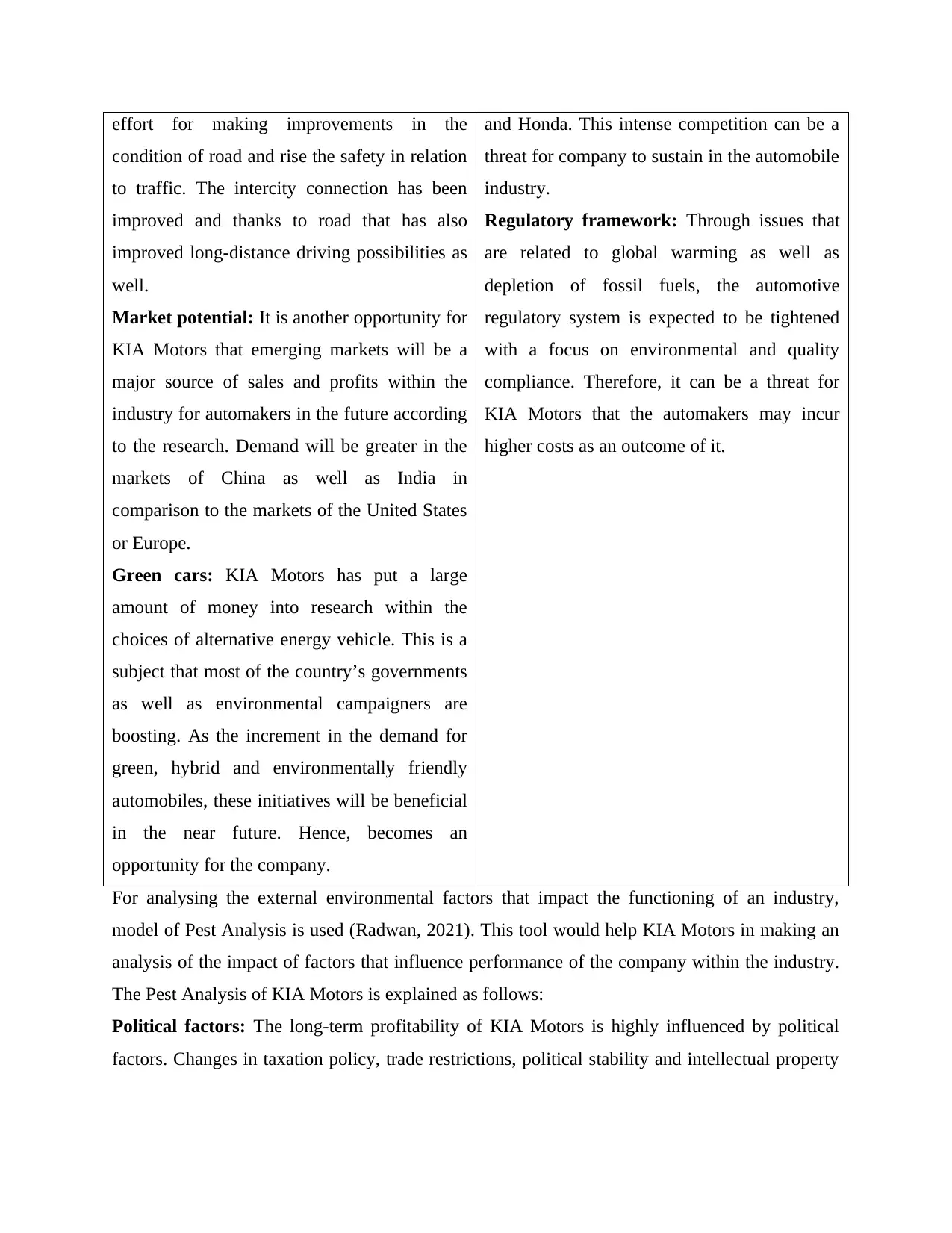
effort for making improvements in the
condition of road and rise the safety in relation
to traffic. The intercity connection has been
improved and thanks to road that has also
improved long-distance driving possibilities as
well.
Market potential: It is another opportunity for
KIA Motors that emerging markets will be a
major source of sales and profits within the
industry for automakers in the future according
to the research. Demand will be greater in the
markets of China as well as India in
comparison to the markets of the United States
or Europe.
Green cars: KIA Motors has put a large
amount of money into research within the
choices of alternative energy vehicle. This is a
subject that most of the country’s governments
as well as environmental campaigners are
boosting. As the increment in the demand for
green, hybrid and environmentally friendly
automobiles, these initiatives will be beneficial
in the near future. Hence, becomes an
opportunity for the company.
and Honda. This intense competition can be a
threat for company to sustain in the automobile
industry.
Regulatory framework: Through issues that
are related to global warming as well as
depletion of fossil fuels, the automotive
regulatory system is expected to be tightened
with a focus on environmental and quality
compliance. Therefore, it can be a threat for
KIA Motors that the automakers may incur
higher costs as an outcome of it.
For analysing the external environmental factors that impact the functioning of an industry,
model of Pest Analysis is used (Radwan, 2021). This tool would help KIA Motors in making an
analysis of the impact of factors that influence performance of the company within the industry.
The Pest Analysis of KIA Motors is explained as follows:
Political factors: The long-term profitability of KIA Motors is highly influenced by political
factors. Changes in taxation policy, trade restrictions, political stability and intellectual property
condition of road and rise the safety in relation
to traffic. The intercity connection has been
improved and thanks to road that has also
improved long-distance driving possibilities as
well.
Market potential: It is another opportunity for
KIA Motors that emerging markets will be a
major source of sales and profits within the
industry for automakers in the future according
to the research. Demand will be greater in the
markets of China as well as India in
comparison to the markets of the United States
or Europe.
Green cars: KIA Motors has put a large
amount of money into research within the
choices of alternative energy vehicle. This is a
subject that most of the country’s governments
as well as environmental campaigners are
boosting. As the increment in the demand for
green, hybrid and environmentally friendly
automobiles, these initiatives will be beneficial
in the near future. Hence, becomes an
opportunity for the company.
and Honda. This intense competition can be a
threat for company to sustain in the automobile
industry.
Regulatory framework: Through issues that
are related to global warming as well as
depletion of fossil fuels, the automotive
regulatory system is expected to be tightened
with a focus on environmental and quality
compliance. Therefore, it can be a threat for
KIA Motors that the automakers may incur
higher costs as an outcome of it.
For analysing the external environmental factors that impact the functioning of an industry,
model of Pest Analysis is used (Radwan, 2021). This tool would help KIA Motors in making an
analysis of the impact of factors that influence performance of the company within the industry.
The Pest Analysis of KIA Motors is explained as follows:
Political factors: The long-term profitability of KIA Motors is highly influenced by political
factors. Changes in taxation policy, trade restrictions, political stability and intellectual property
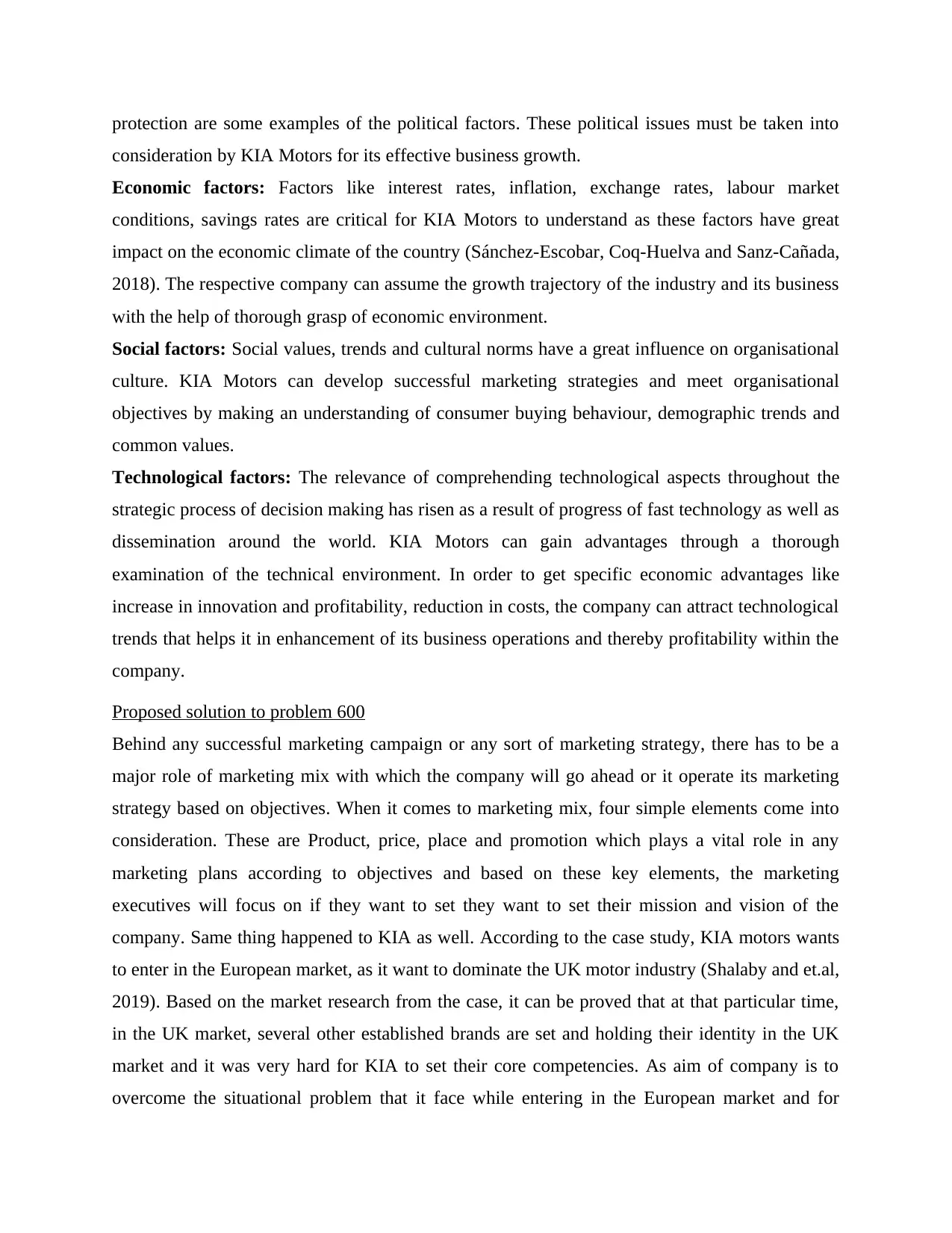
protection are some examples of the political factors. These political issues must be taken into
consideration by KIA Motors for its effective business growth.
Economic factors: Factors like interest rates, inflation, exchange rates, labour market
conditions, savings rates are critical for KIA Motors to understand as these factors have great
impact on the economic climate of the country (Sánchez-Escobar, Coq-Huelva and Sanz-Cañada,
2018). The respective company can assume the growth trajectory of the industry and its business
with the help of thorough grasp of economic environment.
Social factors: Social values, trends and cultural norms have a great influence on organisational
culture. KIA Motors can develop successful marketing strategies and meet organisational
objectives by making an understanding of consumer buying behaviour, demographic trends and
common values.
Technological factors: The relevance of comprehending technological aspects throughout the
strategic process of decision making has risen as a result of progress of fast technology as well as
dissemination around the world. KIA Motors can gain advantages through a thorough
examination of the technical environment. In order to get specific economic advantages like
increase in innovation and profitability, reduction in costs, the company can attract technological
trends that helps it in enhancement of its business operations and thereby profitability within the
company.
Proposed solution to problem 600
Behind any successful marketing campaign or any sort of marketing strategy, there has to be a
major role of marketing mix with which the company will go ahead or it operate its marketing
strategy based on objectives. When it comes to marketing mix, four simple elements come into
consideration. These are Product, price, place and promotion which plays a vital role in any
marketing plans according to objectives and based on these key elements, the marketing
executives will focus on if they want to set they want to set their mission and vision of the
company. Same thing happened to KIA as well. According to the case study, KIA motors wants
to enter in the European market, as it want to dominate the UK motor industry (Shalaby and et.al,
2019). Based on the market research from the case, it can be proved that at that particular time,
in the UK market, several other established brands are set and holding their identity in the UK
market and it was very hard for KIA to set their core competencies. As aim of company is to
overcome the situational problem that it face while entering in the European market and for
consideration by KIA Motors for its effective business growth.
Economic factors: Factors like interest rates, inflation, exchange rates, labour market
conditions, savings rates are critical for KIA Motors to understand as these factors have great
impact on the economic climate of the country (Sánchez-Escobar, Coq-Huelva and Sanz-Cañada,
2018). The respective company can assume the growth trajectory of the industry and its business
with the help of thorough grasp of economic environment.
Social factors: Social values, trends and cultural norms have a great influence on organisational
culture. KIA Motors can develop successful marketing strategies and meet organisational
objectives by making an understanding of consumer buying behaviour, demographic trends and
common values.
Technological factors: The relevance of comprehending technological aspects throughout the
strategic process of decision making has risen as a result of progress of fast technology as well as
dissemination around the world. KIA Motors can gain advantages through a thorough
examination of the technical environment. In order to get specific economic advantages like
increase in innovation and profitability, reduction in costs, the company can attract technological
trends that helps it in enhancement of its business operations and thereby profitability within the
company.
Proposed solution to problem 600
Behind any successful marketing campaign or any sort of marketing strategy, there has to be a
major role of marketing mix with which the company will go ahead or it operate its marketing
strategy based on objectives. When it comes to marketing mix, four simple elements come into
consideration. These are Product, price, place and promotion which plays a vital role in any
marketing plans according to objectives and based on these key elements, the marketing
executives will focus on if they want to set they want to set their mission and vision of the
company. Same thing happened to KIA as well. According to the case study, KIA motors wants
to enter in the European market, as it want to dominate the UK motor industry (Shalaby and et.al,
2019). Based on the market research from the case, it can be proved that at that particular time,
in the UK market, several other established brands are set and holding their identity in the UK
market and it was very hard for KIA to set their core competencies. As aim of company is to
overcome the situational problem that it face while entering in the European market and for
Secure Best Marks with AI Grader
Need help grading? Try our AI Grader for instant feedback on your assignments.
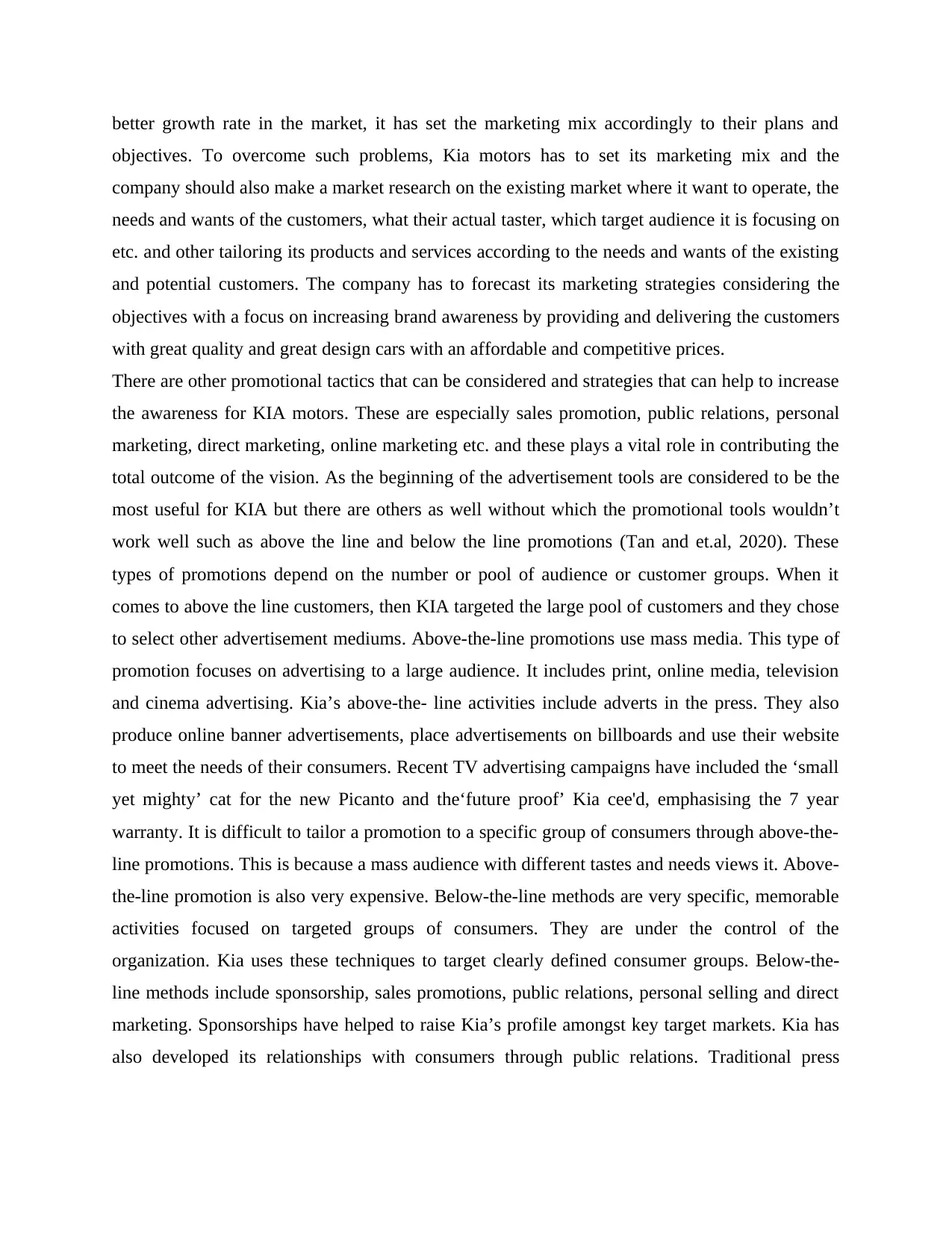
better growth rate in the market, it has set the marketing mix accordingly to their plans and
objectives. To overcome such problems, Kia motors has to set its marketing mix and the
company should also make a market research on the existing market where it want to operate, the
needs and wants of the customers, what their actual taster, which target audience it is focusing on
etc. and other tailoring its products and services according to the needs and wants of the existing
and potential customers. The company has to forecast its marketing strategies considering the
objectives with a focus on increasing brand awareness by providing and delivering the customers
with great quality and great design cars with an affordable and competitive prices.
There are other promotional tactics that can be considered and strategies that can help to increase
the awareness for KIA motors. These are especially sales promotion, public relations, personal
marketing, direct marketing, online marketing etc. and these plays a vital role in contributing the
total outcome of the vision. As the beginning of the advertisement tools are considered to be the
most useful for KIA but there are others as well without which the promotional tools wouldn’t
work well such as above the line and below the line promotions (Tan and et.al, 2020). These
types of promotions depend on the number or pool of audience or customer groups. When it
comes to above the line customers, then KIA targeted the large pool of customers and they chose
to select other advertisement mediums. Above-the-line promotions use mass media. This type of
promotion focuses on advertising to a large audience. It includes print, online media, television
and cinema advertising. Kia’s above-the- line activities include adverts in the press. They also
produce online banner advertisements, place advertisements on billboards and use their website
to meet the needs of their consumers. Recent TV advertising campaigns have included the ‘small
yet mighty’ cat for the new Picanto and the‘future proof’ Kia cee'd, emphasising the 7 year
warranty. It is difficult to tailor a promotion to a specific group of consumers through above-the-
line promotions. This is because a mass audience with different tastes and needs views it. Above-
the-line promotion is also very expensive. Below-the-line methods are very specific, memorable
activities focused on targeted groups of consumers. They are under the control of the
organization. Kia uses these techniques to target clearly defined consumer groups. Below-the-
line methods include sponsorship, sales promotions, public relations, personal selling and direct
marketing. Sponsorships have helped to raise Kia’s profile amongst key target markets. Kia has
also developed its relationships with consumers through public relations. Traditional press
objectives. To overcome such problems, Kia motors has to set its marketing mix and the
company should also make a market research on the existing market where it want to operate, the
needs and wants of the customers, what their actual taster, which target audience it is focusing on
etc. and other tailoring its products and services according to the needs and wants of the existing
and potential customers. The company has to forecast its marketing strategies considering the
objectives with a focus on increasing brand awareness by providing and delivering the customers
with great quality and great design cars with an affordable and competitive prices.
There are other promotional tactics that can be considered and strategies that can help to increase
the awareness for KIA motors. These are especially sales promotion, public relations, personal
marketing, direct marketing, online marketing etc. and these plays a vital role in contributing the
total outcome of the vision. As the beginning of the advertisement tools are considered to be the
most useful for KIA but there are others as well without which the promotional tools wouldn’t
work well such as above the line and below the line promotions (Tan and et.al, 2020). These
types of promotions depend on the number or pool of audience or customer groups. When it
comes to above the line customers, then KIA targeted the large pool of customers and they chose
to select other advertisement mediums. Above-the-line promotions use mass media. This type of
promotion focuses on advertising to a large audience. It includes print, online media, television
and cinema advertising. Kia’s above-the- line activities include adverts in the press. They also
produce online banner advertisements, place advertisements on billboards and use their website
to meet the needs of their consumers. Recent TV advertising campaigns have included the ‘small
yet mighty’ cat for the new Picanto and the‘future proof’ Kia cee'd, emphasising the 7 year
warranty. It is difficult to tailor a promotion to a specific group of consumers through above-the-
line promotions. This is because a mass audience with different tastes and needs views it. Above-
the-line promotion is also very expensive. Below-the-line methods are very specific, memorable
activities focused on targeted groups of consumers. They are under the control of the
organization. Kia uses these techniques to target clearly defined consumer groups. Below-the-
line methods include sponsorship, sales promotions, public relations, personal selling and direct
marketing. Sponsorships have helped to raise Kia’s profile amongst key target markets. Kia has
also developed its relationships with consumers through public relations. Traditional press
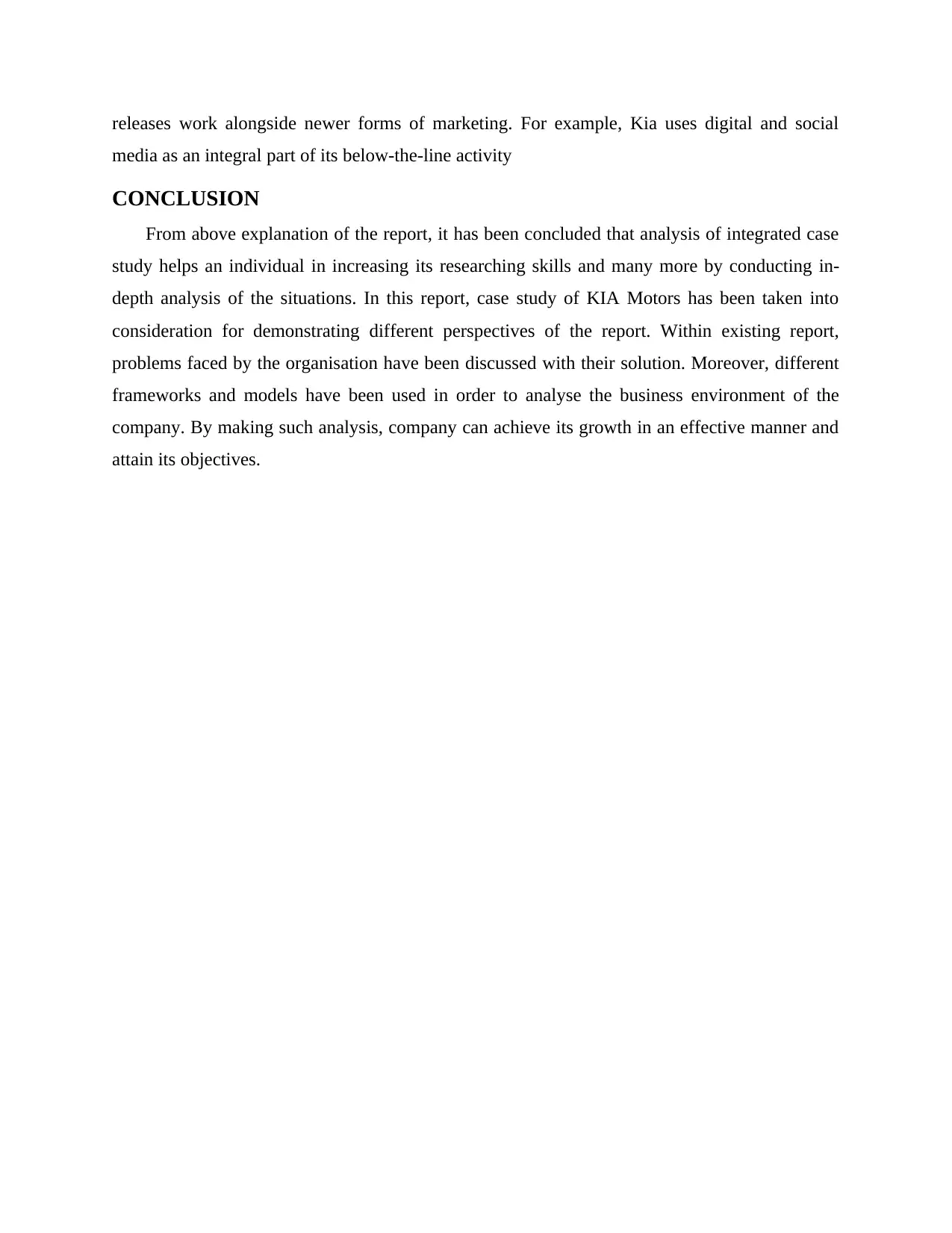
releases work alongside newer forms of marketing. For example, Kia uses digital and social
media as an integral part of its below-the-line activity
CONCLUSION
From above explanation of the report, it has been concluded that analysis of integrated case
study helps an individual in increasing its researching skills and many more by conducting in-
depth analysis of the situations. In this report, case study of KIA Motors has been taken into
consideration for demonstrating different perspectives of the report. Within existing report,
problems faced by the organisation have been discussed with their solution. Moreover, different
frameworks and models have been used in order to analyse the business environment of the
company. By making such analysis, company can achieve its growth in an effective manner and
attain its objectives.
media as an integral part of its below-the-line activity
CONCLUSION
From above explanation of the report, it has been concluded that analysis of integrated case
study helps an individual in increasing its researching skills and many more by conducting in-
depth analysis of the situations. In this report, case study of KIA Motors has been taken into
consideration for demonstrating different perspectives of the report. Within existing report,
problems faced by the organisation have been discussed with their solution. Moreover, different
frameworks and models have been used in order to analyse the business environment of the
company. By making such analysis, company can achieve its growth in an effective manner and
attain its objectives.
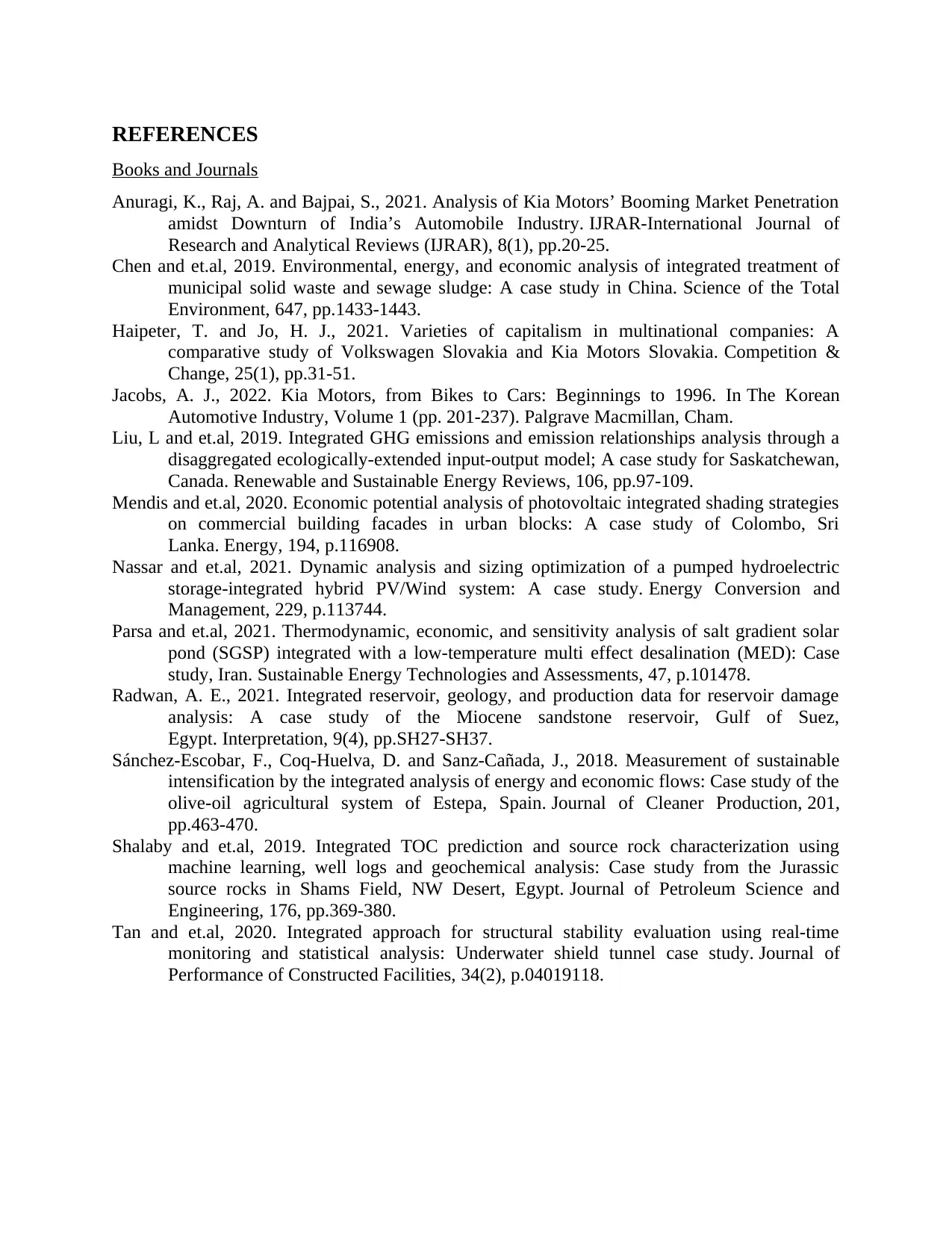
REFERENCES
Books and Journals
Anuragi, K., Raj, A. and Bajpai, S., 2021. Analysis of Kia Motors’ Booming Market Penetration
amidst Downturn of India’s Automobile Industry. IJRAR-International Journal of
Research and Analytical Reviews (IJRAR), 8(1), pp.20-25.
Chen and et.al, 2019. Environmental, energy, and economic analysis of integrated treatment of
municipal solid waste and sewage sludge: A case study in China. Science of the Total
Environment, 647, pp.1433-1443.
Haipeter, T. and Jo, H. J., 2021. Varieties of capitalism in multinational companies: A
comparative study of Volkswagen Slovakia and Kia Motors Slovakia. Competition &
Change, 25(1), pp.31-51.
Jacobs, A. J., 2022. Kia Motors, from Bikes to Cars: Beginnings to 1996. In The Korean
Automotive Industry, Volume 1 (pp. 201-237). Palgrave Macmillan, Cham.
Liu, L and et.al, 2019. Integrated GHG emissions and emission relationships analysis through a
disaggregated ecologically-extended input-output model; A case study for Saskatchewan,
Canada. Renewable and Sustainable Energy Reviews, 106, pp.97-109.
Mendis and et.al, 2020. Economic potential analysis of photovoltaic integrated shading strategies
on commercial building facades in urban blocks: A case study of Colombo, Sri
Lanka. Energy, 194, p.116908.
Nassar and et.al, 2021. Dynamic analysis and sizing optimization of a pumped hydroelectric
storage-integrated hybrid PV/Wind system: A case study. Energy Conversion and
Management, 229, p.113744.
Parsa and et.al, 2021. Thermodynamic, economic, and sensitivity analysis of salt gradient solar
pond (SGSP) integrated with a low-temperature multi effect desalination (MED): Case
study, Iran. Sustainable Energy Technologies and Assessments, 47, p.101478.
Radwan, A. E., 2021. Integrated reservoir, geology, and production data for reservoir damage
analysis: A case study of the Miocene sandstone reservoir, Gulf of Suez,
Egypt. Interpretation, 9(4), pp.SH27-SH37.
Sánchez-Escobar, F., Coq-Huelva, D. and Sanz-Cañada, J., 2018. Measurement of sustainable
intensification by the integrated analysis of energy and economic flows: Case study of the
olive-oil agricultural system of Estepa, Spain. Journal of Cleaner Production, 201,
pp.463-470.
Shalaby and et.al, 2019. Integrated TOC prediction and source rock characterization using
machine learning, well logs and geochemical analysis: Case study from the Jurassic
source rocks in Shams Field, NW Desert, Egypt. Journal of Petroleum Science and
Engineering, 176, pp.369-380.
Tan and et.al, 2020. Integrated approach for structural stability evaluation using real-time
monitoring and statistical analysis: Underwater shield tunnel case study. Journal of
Performance of Constructed Facilities, 34(2), p.04019118.
Books and Journals
Anuragi, K., Raj, A. and Bajpai, S., 2021. Analysis of Kia Motors’ Booming Market Penetration
amidst Downturn of India’s Automobile Industry. IJRAR-International Journal of
Research and Analytical Reviews (IJRAR), 8(1), pp.20-25.
Chen and et.al, 2019. Environmental, energy, and economic analysis of integrated treatment of
municipal solid waste and sewage sludge: A case study in China. Science of the Total
Environment, 647, pp.1433-1443.
Haipeter, T. and Jo, H. J., 2021. Varieties of capitalism in multinational companies: A
comparative study of Volkswagen Slovakia and Kia Motors Slovakia. Competition &
Change, 25(1), pp.31-51.
Jacobs, A. J., 2022. Kia Motors, from Bikes to Cars: Beginnings to 1996. In The Korean
Automotive Industry, Volume 1 (pp. 201-237). Palgrave Macmillan, Cham.
Liu, L and et.al, 2019. Integrated GHG emissions and emission relationships analysis through a
disaggregated ecologically-extended input-output model; A case study for Saskatchewan,
Canada. Renewable and Sustainable Energy Reviews, 106, pp.97-109.
Mendis and et.al, 2020. Economic potential analysis of photovoltaic integrated shading strategies
on commercial building facades in urban blocks: A case study of Colombo, Sri
Lanka. Energy, 194, p.116908.
Nassar and et.al, 2021. Dynamic analysis and sizing optimization of a pumped hydroelectric
storage-integrated hybrid PV/Wind system: A case study. Energy Conversion and
Management, 229, p.113744.
Parsa and et.al, 2021. Thermodynamic, economic, and sensitivity analysis of salt gradient solar
pond (SGSP) integrated with a low-temperature multi effect desalination (MED): Case
study, Iran. Sustainable Energy Technologies and Assessments, 47, p.101478.
Radwan, A. E., 2021. Integrated reservoir, geology, and production data for reservoir damage
analysis: A case study of the Miocene sandstone reservoir, Gulf of Suez,
Egypt. Interpretation, 9(4), pp.SH27-SH37.
Sánchez-Escobar, F., Coq-Huelva, D. and Sanz-Cañada, J., 2018. Measurement of sustainable
intensification by the integrated analysis of energy and economic flows: Case study of the
olive-oil agricultural system of Estepa, Spain. Journal of Cleaner Production, 201,
pp.463-470.
Shalaby and et.al, 2019. Integrated TOC prediction and source rock characterization using
machine learning, well logs and geochemical analysis: Case study from the Jurassic
source rocks in Shams Field, NW Desert, Egypt. Journal of Petroleum Science and
Engineering, 176, pp.369-380.
Tan and et.al, 2020. Integrated approach for structural stability evaluation using real-time
monitoring and statistical analysis: Underwater shield tunnel case study. Journal of
Performance of Constructed Facilities, 34(2), p.04019118.
1 out of 13
Related Documents
Your All-in-One AI-Powered Toolkit for Academic Success.
+13062052269
info@desklib.com
Available 24*7 on WhatsApp / Email
![[object Object]](/_next/static/media/star-bottom.7253800d.svg)
Unlock your academic potential
© 2024 | Zucol Services PVT LTD | All rights reserved.



